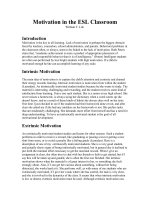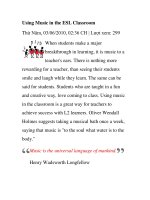Doing Things with Sentences in the ESL Classroom
Bạn đang xem bản rút gọn của tài liệu. Xem và tải ngay bản đầy đủ của tài liệu tại đây (76.57 KB, 4 trang )
Doing Things with Sentences in the ESL
Classroom
Simon Mumford
We can have fun with sentences, mixing up words, taking them apart and putting them
back together, in similar ways to word games. What we do with letters in word games we
can do with words in sentences games. However, because grammar is different from
spelling, the demands on the students are different, and I feel there are more possibilities
for 'sentence games' than word games because of the complexity of grammar. This
complexity means there are limited choices of which word could fill which space, which in
turn means students need to draw on their knowledge of grammar to play the game, guess
the missing word and put the words in order, as they consider the possibilities. Here are
some ideas.
Hunt the Main Verb
Think of a sentence of about eight words, and draw a numbered blank for each on the
board. Now challenge the students to find the main verb in four guesses. Ask one student to
call out a number, and fill this blank with the appropriate word. Assuming that the main
verb has not been found, ask for the next guess. Using the words that have been revealed
as a guide to the structure of the sentence, they should have a better idea of where the main
verb is likely to be. Tell the class that if they find it in four guesses, they have won. If not,
the teacher is the winner.
Swapping Words Around
This uses a mixed-up sentence which students have to put in the correct order. However
there is a rule! Students are only allowed to swap the places of two words each move.
Write the words, in any order in a straight line on the board. Give them a limited number of
moves, say six for a nine word sentence. In other words, they have to sort out a nine word
mixed-up sentence by moving two words each turn, in six turns. In each turn, the chosen
words must be put in the place of the other. Make it easier by showing them the original
sentence first, if you feel this is too difficult.
All Those in Favour
Write the jumbled sentence on the board, and a numbered blank for each word. Ask
individual students to nominate words for blanks. After each suggestion, take a vote. If
more than half the class agrees, write the word in. In subsequent turns students can move
words already placed on the board with the consent of the class. Continue like this, so that
the final correct sentence is reached by consensus.
Minefield
This is a jumbled sentence game for groups of four. One student is the referee and has a
piece of paper with the sentence in the correct order, with one extra space included,
representing the 'mine'. The other players play with a piece of paper with numbered blanks
and the words mixed up. They take it in turns to nominate words for each blank. Each word
correctly placed scores a point for that player and all players write that word in the blank.
However, if one player chooses the blank designated as the 'mine', he is immediately blown
out of the game!
Words That Go Together
Think of a sentence suitable for the level of class you are teaching, e.g. for intermediate
level:
'If it rains tomorrow, we will definitely stay at home.'
Write the jumbled up sentence on the board as shown below:
'tomorrow definitely If stay home it will at rains we'
Divide the class in two teams and ask them to find pairs of words that could be found
together in the sentence, for example 'to+the' could go together because they could be
found in that order, whereas 'the+to' is grammatically incorrect, similarly, 'give+him' is
OK, 'him+give' is not. Ask each team in turn to give different pairs of words that go
together. The first team to give seven correct pairs gets a chance to guess the whole
sentence. If they are wrong, give the other team a chance. The rationale is that students
think about the possible combinations of words before they guess the whole sentence.
Begin in the Middle
Write the middle word of the sentence on the board, and then give the class the two words
that go one either side of it in the sentence. The students' task is to decide which goes in
front and which goes behind. If they choose correctly, write the words in their places on
either side, then give them the next pair, then another, and so on until the sentence is
complete. Thus, if the original sentence was 'Mary said she wished she had a big new red
Mercedes', start with 'had', the first pair would be 'she' and 'a', and the second 'big' and
'wished'. To make it competitive, they lose a life for each wrong decision. If they lose three
lives, they have lost the game.
Mind Reading Students
Tell the students you have thought of a sentence. Give them the number of words in your
sentence e.g. ten words, also the first word, e.g. 'I', and the tense to be used, e.g. present
perfect. Ask for possible answers. In fact, you have not thought of a sentence but work with
the students' answers until you get a correct sentence of the required length. Encourage
students to play around with sentences until they hit the required word number, but you
will probably need to help. For example one student may say 'I have lived in Paris since
2000.' This sentence is too short, so write it on the board but leave spaces, so you can
change it to 'I have lived in Paris since I moved in 2000', or 'I have lived in Paris since the
beginning of 2000'. If the sentence is too long, e.g. 'I and my wife have been married since
the first of October 2000', take away words, e.g. 'My wife and I have been married since
October 2000.' The point is to make students think they are reading your mind, by finding
the sentences so quickly, so pretend to be surprised when they are successful.
Sentence Fan
Make the fan as follows: take two pieces of A4 paper and stick them together lengthwise
(i.e. landscape, not portrait). Fold the paper so it has eight sections, i.e. fold it in half, then
in half again, then in half again. Using the folds as guides, make a fan, by folding alternate
creases in different directions. Now, choose an eight word sentence, and write one word in
each section. Write it so that when you hold the top of the fan and let the bottom fall to the
ground, the sentence can be read vertically, i.e. from top to bottom. Show the class the back
of the fan (the blank side) and ask how many words are in the sentence. Reveal words one
or two at a time (not necessarily in order) by folding and unfolding different sections. Ask
students to try to guess the whole sentence. Let the fan open completely but close it again
before the students get a good look. Again, ask them what the sentence is. Students making
their own fans and practising on each other could be the next stage.
Threes
Choose a twelve word sentence e.g. 'My mother went to the shops but has not come back
yet.' Write the words alternately in three sections.
1 My to but come 2 mother the has back 3 went shops not yet
Next, mix the words up within the sections and write them on the board.
1 to My come but 2 back mother has the 3 yet not went shops
Put students in groups of three, give each student a number, 1, 2, or 3 and ask them to say
one word from their box in turn. Explain that the boxes are in order but the words are not.
Encourage them to experiment with different orders until they find one that sounds right.
( Note: leaving the capital letter on 'My' will help them to start.)
Conclusion
Sentences are composed of words. The order of words in a sentence is a pattern. If we can
give students activities where they need to use their knowledge of grammar to find these
patterns they will be activating their language, while game and competitive elements mean
they are having fun at the same time.









